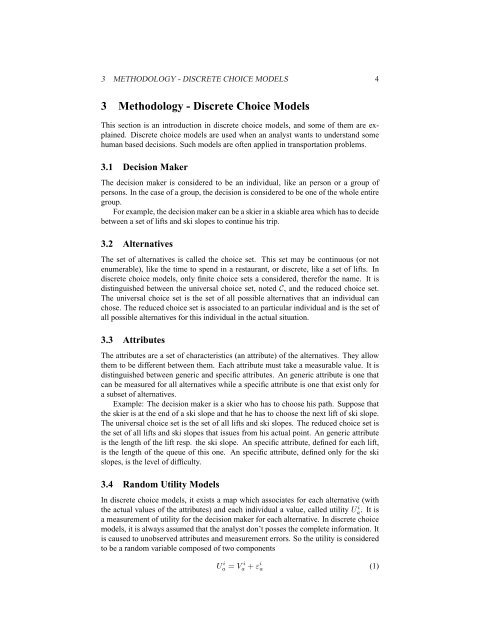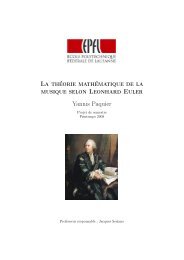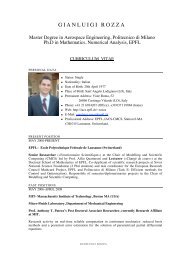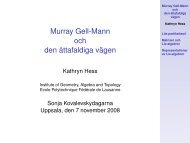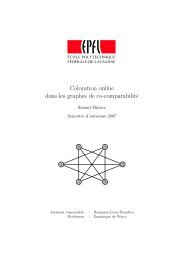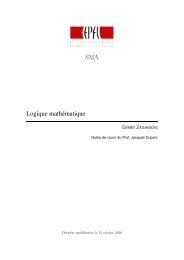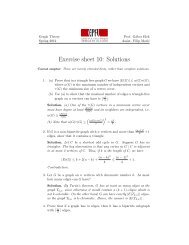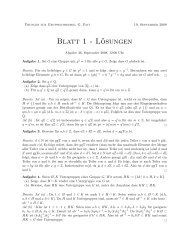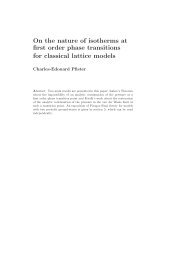Decision Models in Skiable Areas - EPFL
Decision Models in Skiable Areas - EPFL
Decision Models in Skiable Areas - EPFL
Create successful ePaper yourself
Turn your PDF publications into a flip-book with our unique Google optimized e-Paper software.
3 METHODOLOGY - DISCRETE CHOICE MODELS 4<br />
3 Methodology - Discrete Choice <strong>Models</strong><br />
This section is an <strong>in</strong>troduction <strong>in</strong> discrete choice models, and some of them are expla<strong>in</strong>ed.<br />
Discrete choice models are used when an analyst wants to understand some<br />
human based decisions. Such models are often applied <strong>in</strong> transportation problems.<br />
3.1 <strong>Decision</strong> Maker<br />
The decision maker is considered to be an <strong>in</strong>dividual, like an person or a group of<br />
persons. In the case of a group, the decision is considered to be one of the whole entire<br />
group.<br />
For example, the decision maker can be a skier <strong>in</strong> a skiable area which has to decide<br />
between a set of lifts and ski slopes to cont<strong>in</strong>ue his trip.<br />
3.2 Alternatives<br />
The set of alternatives is called the choice set. This set may be cont<strong>in</strong>uous (or not<br />
enumerable), like the time to spend <strong>in</strong> a restaurant, or discrete, like a set of lifts. In<br />
discrete choice models, only f<strong>in</strong>ite choice sets a considered, therefor the name. It is<br />
dist<strong>in</strong>guished between the universal choice set, noted C, and the reduced choice set.<br />
The universal choice set is the set of all possible alternatives that an <strong>in</strong>dividual can<br />
chose. The reduced choice set is associated to an particular <strong>in</strong>dividual and is the set of<br />
all possible alternatives for this <strong>in</strong>dividual <strong>in</strong> the actual situation.<br />
3.3 Attributes<br />
The attributes are a set of characteristics (an attribute) of the alternatives. They allow<br />
them to be different between them. Each attribute must take a measurable value. It is<br />
dist<strong>in</strong>guished between generic and specific attributes. An generic attribute is one that<br />
can be measured for all alternatives while a specific attribute is one that exist only for<br />
a subset of alternatives.<br />
Example: The decision maker is a skier who has to choose his path. Suppose that<br />
the skier is at the end of a ski slope and that he has to choose the next lift of ski slope.<br />
The universal choice set is the set of all lifts and ski slopes. The reduced choice set is<br />
the set of all lifts and ski slopes that issues from his actual po<strong>in</strong>t. An generic attribute<br />
is the length of the lift resp. the ski slope. An specific attribute, def<strong>in</strong>ed for each lift,<br />
is the length of the queue of this one. An specific attribute, def<strong>in</strong>ed only for the ski<br />
slopes, is the level of difficulty.<br />
3.4 Random Utility <strong>Models</strong><br />
In discrete choice models, it exists a map which associates for each alternative (with<br />
the actual values of the attributes) and each <strong>in</strong>dividual a value, called utility U i a. It is<br />
a measurement of utility for the decision maker for each alternative. In discrete choice<br />
models, it is always assumed that the analyst don’t posses the complete <strong>in</strong>formation. It<br />
is caused to unobserved attributes and measurement errors. So the utility is considered<br />
to be a random variable composed of two components<br />
U i a = V i<br />
a + ε i a<br />
(1)


